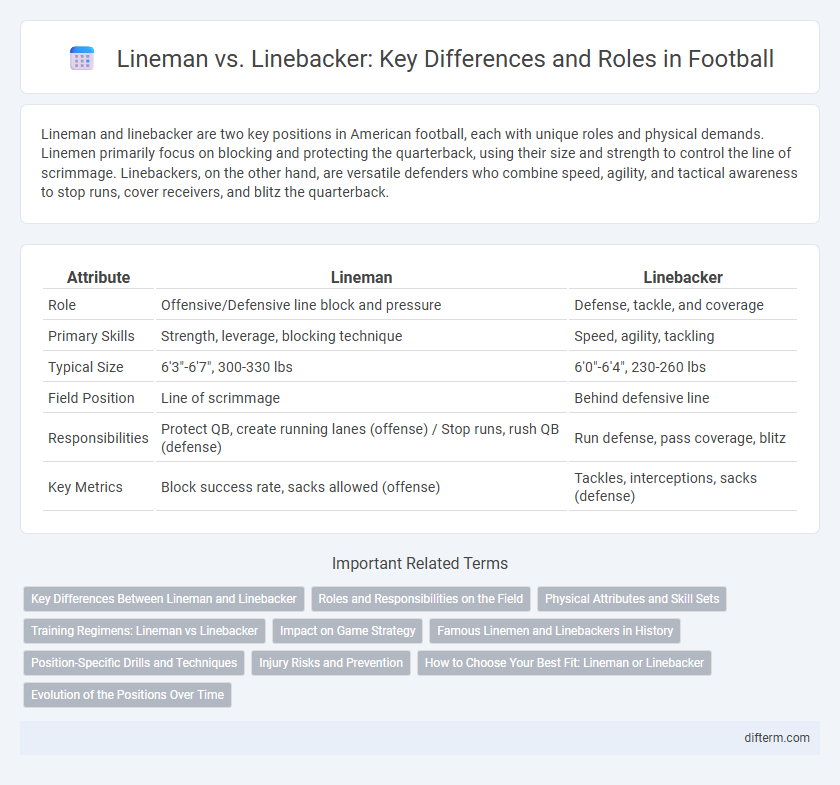Lineman and linebacker are two key positions in American football, each with unique roles and physical demands. Linemen primarily focus on blocking and protecting the quarterback, using their size and strength to control the line of scrimmage. Linebackers, on the other hand, are versatile defenders who combine speed, agility, and tactical awareness to stop runs, cover receivers, and blitz the quarterback.
Table of Comparison
| Attribute | Lineman | Linebacker |
|---|---|---|
| Role | Offensive/Defensive line block and pressure | Defense, tackle, and coverage |
| Primary Skills | Strength, leverage, blocking technique | Speed, agility, tackling |
| Typical Size | 6'3"-6'7", 300-330 lbs | 6'0"-6'4", 230-260 lbs |
| Field Position | Line of scrimmage | Behind defensive line |
| Responsibilities | Protect QB, create running lanes (offense) / Stop runs, rush QB (defense) | Run defense, pass coverage, blitz |
| Key Metrics | Block success rate, sacks allowed (offense) | Tackles, interceptions, sacks (defense) |
Key Differences Between Lineman and Linebacker
Lineman primarily focus on controlling the line of scrimmage with roles split between offensive linemen who protect the quarterback and create running paths, and defensive linemen who aim to disrupt offensive plays by tackling or sacking the quarterback. Linebackers operate behind the defensive line, combining pass coverage, run defense, and blitzing responsibilities with greater agility to read offensive formations and react accordingly. The key differences lie in positioning, with linemen engaging directly on the line, and linebackers utilizing versatility and speed to defend against both run and pass plays.
Roles and Responsibilities on the Field
Lineman primarily focus on blocking offensive or defensive plays, with offensive linemen protecting the quarterback and creating running lanes, while defensive linemen aim to penetrate the offensive line and disrupt plays. Linebackers serve as versatile defenders, responsible for stopping the run, covering receivers in the passing game, and blitzing the quarterback. Both positions require strength and agility, but linebackers have a broader role involving tactical awareness and quick decision-making in various defensive schemes.
Physical Attributes and Skill Sets
Lineman possess exceptional size and strength, often exceeding 300 pounds, with explosive power essential for blocking and tackling at the line of scrimmage. Linebackers combine agility and speed with robust tackling ability, typically ranging from 230 to 260 pounds, enabling quick coverage and effective run defense. While linemen excel in brute force and leverage, linebackers require advanced instincts and lateral movement for coverage and blitzing responsibilities.
Training Regimens: Lineman vs Linebacker
Lineman training regimens emphasize explosive strength, heavy weightlifting, and agility drills to enhance blocking and pass protection skills. Linebackers focus on a combination of speed, endurance, and tactical agility through sprint intervals, coverage drills, and strength training for tackling. Both positions require tailored conditioning programs to optimize performance based on their distinct roles in football defense and offense.
Impact on Game Strategy
Lineman control the line of scrimmage by blocking or penetrating to disrupt offensive or defensive plays, directly impacting the pace and formation strategies. Linebackers adapt to both run and pass scenarios, providing versatile coverage and tackling that forces offenses to adjust their play-calling. The interplay between linemen and linebackers shapes defensive alignments and offensive protections, influencing overall game strategy and momentum.
Famous Linemen and Linebackers in History
Famous linemen like Anthony Munoz and Joe Thomas revolutionized offensive line play with unparalleled blocking skills and durability, setting standards for future generations. Legendary linebackers such as Lawrence Taylor and Ray Lewis transformed defensive strategies through their aggressive tackling and leadership on the field. These iconic players elevated their respective positions and left lasting legacies that define modern professional football.
Position-Specific Drills and Techniques
Lineman drills emphasize explosive power and hand technique, including blocking sled workouts and punch drills to master pass protection and run blocking. Linebacker-specific drills focus on agility, tackling, and coverage skills, such as cone drills for lateral quickness, open-field tackling practice, and zone coverage simulations. Mastery of these position-specific techniques is crucial for effective performance on the defensive or offensive front, aligning strength and speed with tactical awareness.
Injury Risks and Prevention
Lineman face high injury risks due to frequent collisions and heavy physical contact, often resulting in concussions, knee ligament tears, and shoulder injuries. Linebackers experience similar dangers but with added risks from rapid directional changes, increasing the likelihood of hamstring strains and ankle sprains. Effective injury prevention strategies include targeted strength training, proper tackling techniques, and the use of advanced protective gear tailored to each position's specific demands.
How to Choose Your Best Fit: Lineman or Linebacker
Choosing between lineman and linebacker involves evaluating your physical attributes and skill sets; linemen require size, strength, and leverage to control the line of scrimmage, while linebackers need agility, speed, and instinct for tackling and coverage. Understanding your ability to read offensive or defensive formations and react quickly is crucial, as linebackers act as the defense's second line and linemen anchor the front. Prioritize training that enhances your core strengths--whether it's power for lineman roles or mobility for linebacker positions--to optimize your fit on the field.
Evolution of the Positions Over Time
Lineman and linebacker roles have evolved significantly as football strategies and athletic demands changed over decades. Linemen have shifted from primarily brute force blockers to more agile and technically skilled players adept at both protection and penetration. Linebackers transitioned from pure run-stoppers to versatile defenders excelling in pass coverage, blitzing, and reading complex offenses.
lineman vs linebacker Infographic

 difterm.com
difterm.com